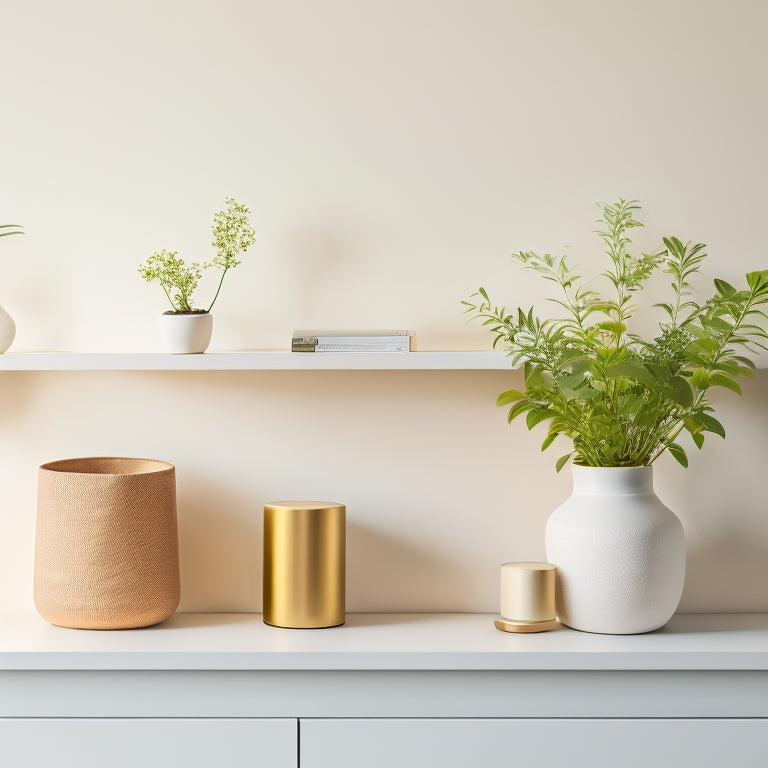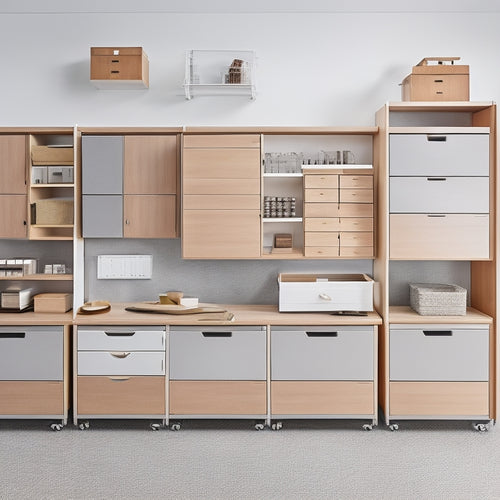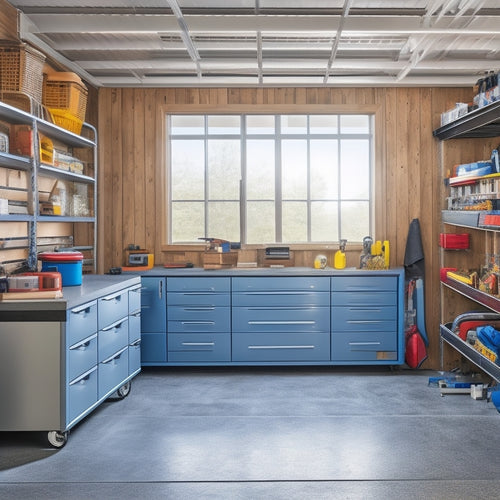
Simple Shelf Organization Ideas for Clutter-Free Homes
Share
You can change your shelves from cluttered chaos to organized oases by following a few simple steps. Start by decluttering your shelves, sorting items into "keep," "donate/sell," and "discard" piles, and evaluating items honestly. Next, categorize and group similar items together, assign a home for each item, and use bins and containers effectively. Don't forget to label everything for easy access and install shelf dividers and risers to optimize shelf space. By following these steps, you'll be well on your way to a clutter-free home, and you'll find even more ways to maximize your shelf space and simplify your life.
Key Takeaways
- Remove all items from shelves, sort into "keep," "donate/sell," and "discard" piles, and evaluate items honestly to declutter.
- Group similar items together, categorize by type, and assign a home for each item to maintain a clutter-free environment.
- Use bins and containers effectively to reduce visual clutter, and choose container types based on items and available space.
- Label everything with readable and suitable labels, using different colors to categorize items or differentiate contents.
- Schedule weekly tidying sessions to restore order, dust shelves regularly, and conduct seasonal reviews to reassess belongings.
Declutter Your Shelves First
Clarity begins with a clean slate, and that's exactly what you'll get when you declutter your shelves.
Start by removing everything from your shelves and sorting items into three piles: keep, donate/sell, and discard. This shelf inventory will help you see what you have and what you can get rid of. Be honest with yourself – if you haven't used something in a year, it's probably safe to let it go.
As you sort, make donation decisions based on the condition and usefulness of each item.
Consider donating gently used books, toys, or household items to local charities or thrift stores. Be sure to check the expiration dates of any consumable items before donating them.
Discard broken or damaged items that can't be repaired or repurposed.
Categorize and Group Similar Items
Now that your shelves are decluttered, it's time to categorize and group similar items. This step is essential in maintaining a clutter-free home, as it allows you to see what you have and where it should go. Start by identifying the different item types you have on your shelves, such as books, decorations, and kitchen items.
| Item Type | Grouping Strategy | Benefits |
|---|---|---|
| Books | Group by author, title, or genre | Easier to find specific books, and similar books are together |
| Decorations | Group by theme, color, or season | Creates a visually appealing display, and similar items are together |
| Kitchen Items | Group by category (baking, cooking, etc.) | Easier to find what you need when cooking, and prevents clutter |
Assign a Home for Each Item
You'll want to designate a spot for each item, so it's easy to find and put back.
Labeling and signing each spot will help you and others quickly identify where things go.
Designate a Spot
Your shelves are a mess, and it's time to get organized. To achieve this, designate a spot for each item on your shelves. This means assigning a specific shelf placement for similar items, creating designated areas for specific categories of items.
For instance, allocate a shelf for books, another for decorative items, and another for kitchen utensils. This strategy helps maintain order and makes it easier to find what you need.
When you designate a spot for each item, you'll avoid clutter buildup and reduce the risk of accidents caused by heavy objects falling from overcrowded shelves. It also saves you time and energy in the long run, as you won't have to search through a disorganized mess to find what you're looking for.
Label and Sign
Behind the designated spot for each item lies the importance of labeling and signing. This step guarantees you can easily identify what's stored in each area, making it simpler to find what you need and maintain your organized space. Effective labeling techniques involve using clear, concise language and placing labels at eye level or near the front of the shelf. Consider using a label maker or writing labels by hand in bold, black markers.
When it comes to sign placement, consider the following guidelines:
| Sign Type | Placement | Purpose |
|---|---|---|
| Shelf labels | Above or on the shelf | Identify contents |
| Bin labels | On the bin or container | Identify contents |
| Section signs | Above a section of shelves | Identify category |
| Caution signs | Near hazardous materials | Warn of potential dangers |
| Directional signs | Near entry/exit points | Guide traffic flow |
Store Out of Sight
By assigning a home for each item, you're ensuring that everything has a designated spot, making it easier to store out of sight and maintain your organized space. This means everything from linens to luggage will have a specific place to call its own, keeping clutter at bay.
To maximize hidden storage, consider using decorative boxes or stylish baskets to stash items like toys, accessories, or office supplies. Under bed storage containers can also keep items like out-of-season clothes or linens out of the way.
Multi-functional furniture solutions, such as wall-mounted shelves or storage ottomans, can provide ample storage without taking up precious floor space.
In closets, use compact designs and wall-mounted shelves to create a sense of openness while keeping items organized. Folding screens can also be used to section off areas and create a sense of separation.
Use Bins and Containers Effectively
As you tackle your shelf organization project, incorporating bins and containers is an essential step in maintaining a clutter-free space. These storage solutions help keep items hidden from view, reducing visual clutter and creating a sense of calm.
When selecting container types, consider the items you need to store and the space available. Clear plastic bins are ideal for storing small toys, craft supplies, or linens, while fabric bins can add a decorative touch to your shelves. Sturdy, stackable containers are perfect for heavy items like books or tools.
Remember to choose containers that fit your shelf dimensions and leave enough space for easy retrieval. Avoid overfilling bins, as this can lead to messy spills and wasted time searching for specific items. Instead, group similar items together and allocate a bin for each category.
Label Everything for Easy Access
Now that you've organized your shelves with bins and containers, it's time to take your system to the next level by labeling everything for easy access. Labels help you quickly identify what's inside each container, making it easier to find what you need and maintain your organized space.
To create an effective labeling system, consider the following:
-
Choose the right label type: Select labels that are easy to read and suitable for your storage environment. For example, waterproof labels are ideal for containers stored in humid areas.
-
Select label colors and designs: Use different label colors to categorize items or differentiate between contents. You can also add icons or images to make your labels more visually appealing.
-
Pick the right label size and material: Confirm labels are large enough to be easily readable, but not so large that they overwhelm the container. Choose label materials that are durable and suitable for your storage conditions.
- Plan label placements and fonts: Place labels in a consistent location on each container, such as the top or side. Use a clear, easy-to-read font to confirm labels are quickly understood.
Install Shelf Dividers and Risers
You can optimize your shelf space by installing dividers and risers, which will help you divide and conquer the area, maximize your vertical storage, and customize your shelf layout to fit your specific needs.
By doing so, you'll be able to create separate zones for different items, make the most of your shelf's vertical space, and tailor the layout to your personal preferences.
This will result in a more organized, efficient, and easy-to-navigate storage system.
Divide and Conquer Space
Behind the cluttered shelves, a hidden world of organized bliss awaits. By dividing and conquering your space, you can create a sense of calm and control.
Installing shelf dividers and risers is a simple yet effective way to achieve this. These clever tools help you make the most of your shelf space by creating separate compartments for different items.
This not only keeps your belongings organized but also prevents clutter from building up in the future. With shelf dividers and risers, you can:
- Create separate zones for different types of items, such as books, decorative objects, and kitchen utensils
- Improve visual balance by grouping similar items together
- Enhance space planning by allocating specific areas for specific tasks or activities
- Prevent items from getting lost or damaged by keeping them separate and organized
Maximize Vertical Storage
Vertical shelves, once a cluttered mess, can be converted into a towering triumph of organization with the strategic installation of shelf dividers and risers. By doing so, you'll create separate compartments that prevent items from toppling over, making it easier to find what you need and reducing the risk of accidents.
Shelf dividers also help you categorize items, keeping similar objects together and ensuring everything has its designated place.
To maximize your vertical storage, consider installing wall-mounted shelves that go up to the ceiling. This will allow you to store infrequently used items, such as seasonal decorations or out-of-season clothing, freeing up precious floor space.
Risers can also be used to create multiple levels of storage within a single shelf, increasing your storage capacity without taking up more floor space.
Customize Shelf Layout
With shelf dividers and risers in place, it's time to customize your shelf layout to fit your specific needs. This involves arranging your shelves in a way that optimizes storage, accessibility, and aesthetic appeal.
Consider the shelf dimensions and the items you plan to store to determine the most efficient layout.
Some key considerations to keep in mind when customizing your shelf layout include:
-
Group similar items together: Store items of the same category, such as books or kitchen utensils, on the same shelf to make them easy to find and access.
-
Prioritize frequently used items: Place frequently used items in easy-to-reach locations, such as the middle or lower shelves, to save time and effort.
-
Leave space for growth: Don't overcrowd your shelves; leave some space for future additions or changes to your storage needs.
- Balance functionality and style: Aim for a layout that not only provides ample storage but also contributes to the overall aesthetic appeal of your space.
Maintain Your Organized Shelves
You've invested time and effort into organizing your shelves, and now it's vital to maintain that organization to keep your space clutter-free and functional. Regular maintenance is key to guaranteeing your shelves remain organized and safe.
Set aside some time each week to tidy up your shelves, putting back items that are out of place and dusting the shelves to prevent dust buildup.
In addition to regular maintenance, it's important to conduct seasonal reviews of your shelves. This involves taking everything off the shelves and reassessing what you need, what you can donate or discard, and what you can replace.
Seasonal reviews help you stay on top of your belongings, prevent clutter from building up, and guarantee your shelves remain functional and organized.
Frequently Asked Questions
How Do I Organize Shelves With Limited Space or Narrow Shelves?
When dealing with limited space or narrow shelves, you'll want to maximize vertical storage by using stacking bins and vertical dividers to keep items organized and accessible, ensuring a safe and clutter-free environment.
Can I Use Decorative Items to Add Visual Appeal to My Shelves?
You can absolutely use decorative items to add visual appeal to your shelves! Incorporate decorative accents that reflect your personal style, and practice shelf styling by balancing items to create a harmonious, clutter-free look that's both beautiful and safe.
How Often Should I Clean and Dust My Organized Shelves?
You'll want to establish a regular cleaning routine, ideally weekly, to maintain dust-free shelves; use gentle dusting techniques, like microfiber cloths, to avoid scratching surfaces or disturbing decorative items, ensuring a safe and clutter-free space.
Are There Any Specific Shelf Organization Ideas for Small Children's Toys?
You're drowning in a sea of toys! Create a playroom oasis with toy storage bins and shelves labeled by category, teaching your little ones to put away toys after playtime, maintaining a clutter-free haven for imagination and learning.
Can I Use Shelf Organization Systems in Closets or Only on Open Shelves?
You can definitely use shelf organization systems in closets, not just on open shelves, to maximize storage and accessibility, enjoying benefits like reduced clutter, increased visibility, and improved safety with adjustable shelf types that fit your needs.
Conclusion
You've finally achieved a clutter-free home by implementing these simple shelf organization ideas! Now, maintain your space by putting things back in their assigned homes after use. Did you know that the average American spends around 1.5 hours a day searching for lost or misplaced items? By keeping your shelves organized, you'll save time and reduce stress. Stay committed to your new habits and enjoy the benefits of a clutter-free life!
Related Posts
-

Modular Tool Storage Systems for Small Spaces
You can optimize your small workspace by leveraging modular tool storage systems that intelligently employ vertical s...
-

Heavy-Duty Pegboard Hooks for Industrial Use
You need heavy-duty pegboard hooks that can withstand the rigors of industrial use, providing a reliable and efficien...
-

Top Rolling Tool Box Drawers for Maximum Storage
When it comes to maximizing storage with rolling tool box drawers, you need a solution that combines durability, cust...


